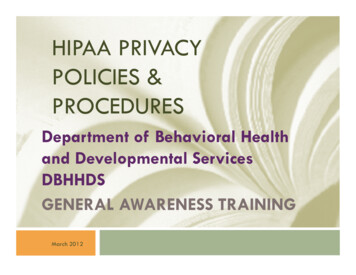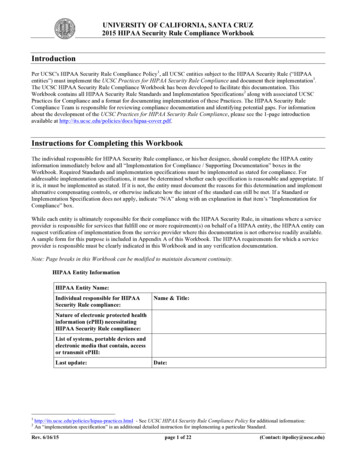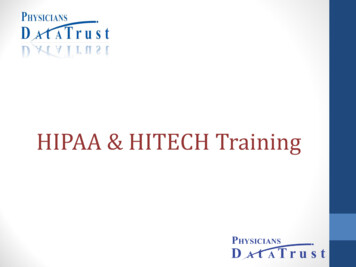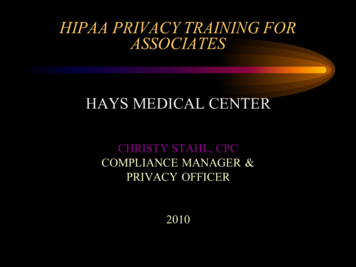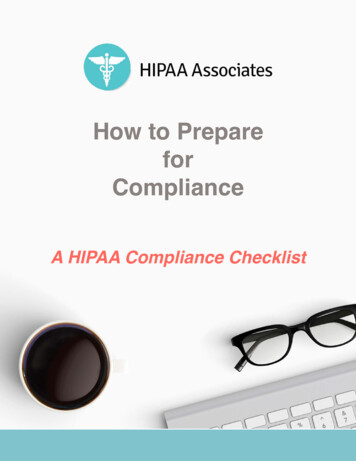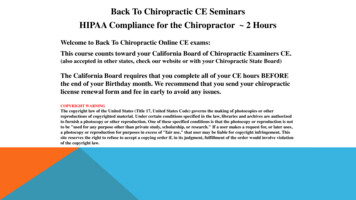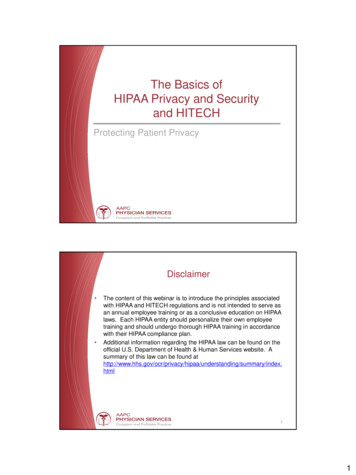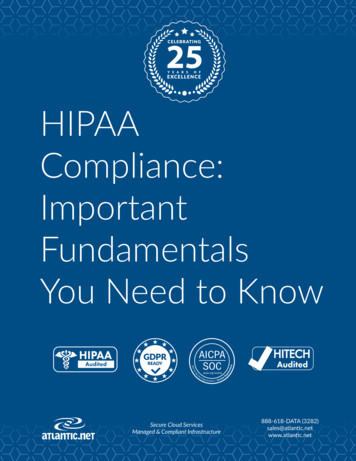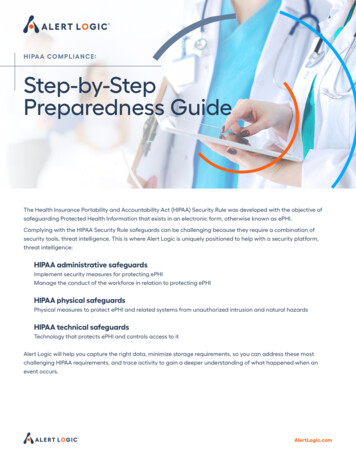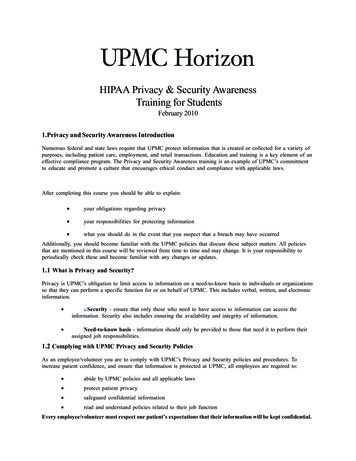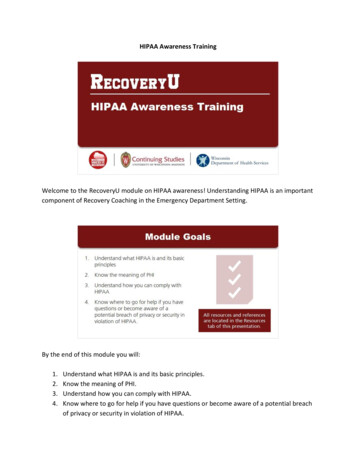
Transcription
Maintaining Patient ConfidentialityHIPAA Complianceby Teri Junge, cst, cfa , fast, bsa HiPaa compliance program is necessary in a medical setting to protect thepatient’s personal, medical and financial information. it will be necessary toshare patient information with other entities, and that must be done legally.this article addresses planning, implementation and evaluation of a HiPaacompliance program.The acronym HIPAA represents the term Health InsurancePortability and Accountability Act, which became federallaw in 1996. Implementation and enforcement of HIPAAis the responsibility of the Office for Civil Rights, whichis part of the US Department of Health and Human Services.1 AHIPAA compliance program is necessary to ensure delivery ofquality health care to the general public and to protect the patient’spersonal, medical and financial information. The two main goalsof the HIPAA program are portability and accountability.2The portability portion of HIPAA was set up to broaden thehealth care options available to an individual by increasing hisor her ability to obtain and maintain health coverage, even whenchanging jobs, or by allowing individuals to purchase healthinsurance if group coverage is not an option. HIPAA also limits exclusions from health insurance coverage due to preexistingand current conditions.3 The portability portion of HIPAA pertains primarily to health plans, and the focus of this article is onthe accountability portion of HIPAA as it pertains to health careproviders and health care clearinghouses. Therefore, additionalinformation concerning portability will not be provided.learning OBJec tivessevaluate your workplace forpotential HiPaa trouble spotssassess your own personalpractices as they relate to HiPaarequirementssexamine the potentialconsequences for noncompliancesCompare and contrast the differentmethods of notifying patients ofthe privacy policysexamine the intricacies of businessassociate agreementsJULY 2009 the surgical technologist 303
The accountability portion of HIPAA was set up toprotect patient privacy in relation to health care. This typeof information is called protected health information,and there are three types of health organizations that arerequired to follow the HIPAA privacy rules. These organizations are called covered entities and include health plans,health care providers, and health care clearing houses.4PERMIT TED USES OF PROTECTED HEALTHINFORMATIONUnder the HIPAA privacy rule, the two main reasons forrelease of protected health information without writtenauthorization or notification are to the individual and tobusiness associates who are directly or indirectly involvedwith treatment, maintenance of treatment records or payment for treatment. Additionally, protected health information may be released in facility directories and to family andfriends involved with the patient’s care. Incidental releaseof information is also allowed, as is release of informationfor the sake of public interest. Limited information may bereleased for research purposes.6POLICIES AND PROCEDURESEach covered entity must appoint an individual as the privacy officer. This person is responsible for creation and maintenance of a HIPAA policy manual that describes all policies and procedures relating to a patient’s protected healthinformation. The policy manual must contain informationconcerning the covered entity’s business associates and theThe accountability portion of HIPAA was set upto protect patient privacy in relation to healthPROTECTED HEALTH INFORMATIONProtected health information (PHI) is defined as any healthinformation that is created or maintained by a coveredentity in any form. Forms of information include handwritten or printed documents, electronic documents, and thespoken word. Protected health information consists of anything that is individually identifiable including the patient’sphysical or mental status (past, present or future), care thathe or she has received, is receiving, or will receive, and themethod of payment for that care.2Protected health information may be released in limitedsituations. The HIPAA Privacy Rule allows protected healthinformation to be released as permitted by the rule or at thewritten request of the patient or the patient’s legal representative. Additionally, information must be released to theUS Department of Health and Human Services if requestedduring an investigation of an alleged HIPAA violation or asrequired by state or federal law.5304 the surgical technologist JULY 2009care. This type of information is called protected health information working agreements that are in place to protect patient information handled by those associates. The manual also includesinformation notifying the patient about how his or her confidential information is used by the covered entity. This isdone via a document called a notice of privacy practices. Thepatient signs an acknowledgment that he or she has receivedthe notice, and that acknowledgment is kept on file. Shouldthe patient choose to have his or her protected health information released, an authorization form must be availablefor the patient, or his or her representative, to sign prior tothat information being released. The privacy officer is alsoresponsible for updating the policy manual as needed, ensuring that all staff receives HIPAA training and that the training is documented in the employee’s file. Additionally, theprivacy officer is to handle all patient questions or complaintsconcerning the covered entity’s privacy practices.2
TABLE 1 7,8ComponentRationalename, address andtelephone number ofcovered entityidentifiable information.name, address andtelephone number ofbusiness associateidentifiable information.Brief explanation ofHiPaaraise awareness of the businessassociate.definition of relatedtermsto eliminate misunderstanding ofcontractual contents (examplesinclude covered entity, businessassociate, individual, protectedhealth information, etc.).list of responsibilities ofthe business associatelist the exact terms of the contractincluding specifics concerning howthe privacy rule is to be followed,timelines for completion of work.list of permittedactivities of the businessassociatedescription of exactly how the protected health information is to beused. also contains a provision toextend the agreement to any subcontractors hired by the businessassociate. lists reporting requirements and limitations.Procedures to followshould a breach ofsecurity occurCovered entity must be notified.list of consequences fornoncomplianceincludes civil monetary penaltiesand federal criminal (monetary andincarceration) penalties.disclosureCovers any possible errors or omissions in the contract and states thatHiPaa regulations will prevail.liability insurancerequirementMay be optional (according to statelaw).signatures and date ofsigningValidation of the contract.notarizationif desired or required by state law.BUSINESS ASSOCIATESA business associate is typically not a covered entity, butis an individual or a business that provides services toa covered entity and has access to a patient’s protectedhealth information. Examples of business associatesinclude (but are not limited to) transcription services,billing services, insurance claims processing services,answering service personnel, accountants, consultants(such as quality assurance or utilization review teams),members of a legal team, etc.7BUSINESS ASSOCIATE AGREEMENTAll business associates of a covered entity who haveaccess to a patient’s protected health information musthave a signed business associate agreement in place. 7According to Hinkley, et al, the required contractual provisions include:s Ensuring that PHI will not be used or disclosed exceptin accordance with the business associate contract;s Ensuring that appropriate safeguards are in place toprotect the confidentiality of PHI;s Requiring business associates to report breaches to thecovered entity;s Requiring agents and subcontractors to complywith the same requirements that apply to businessassociates;s Making PHI available to satisfy patients’ rights;s Making PHI available to satisfy HHS’s right to investigate and enforce HIPAA; ands Returning or destroying all PHI upon termination ofthe agreement, if feasible.7An overview listing the main components of a businessassociate agreement and the rationale for each entry is provided in Table 1.NOTICE OF PRIVACY PRACTICESThe notice of privacy practices must be given to the patientand a signed acknowledgment of receipt must be obtainedprior to the first interaction unless an emergency situationexists. In the case of treatment necessitated by an emergency, the notice must be provided as soon as is feasible following the emergency and a signed receipt is not necessary. Asthe notice of privacy practices is updated, the informationJULY 2009 the surgical technologist 305
need only be available to the patient. This may take place bymaking written brochures available, by posting the information in the reception area, or by posting the updated information on the covered entity’s Web site. As the notice ofprivacy practices is updated, it is not necessary to obtainan updated, signed acknowledgment of receipt from eachpatient as long as the necessary updates are available uponrequest. The document must not use legal or medical terminology, but must be written in terms that most patientscan easily understand.9An overview listing the main components of a noticeof privacy practices and the rationale for each entry is provided in Table 2.TABLE 2 9, 10ComponentRationalename, address, and telephone number of covered entity.identifiable information.Brief explanation of HiPaa and definitions for any terms that the patientmay not understand.Patient education.disclose how private health information is used, stored, and protected.raise awareness of thepatient.explain how changes in the notice ofprivacy practices are handled.general patientinformation.Patient’s rights and responsibilitiesare explained.inform patient ofhis or her rights andresponsibilities.describe the mechanism by whicha patient may make a complaintregarding HiPaa.general patientinformation.explain the legal duties of the covered entity.general patientinformation.list the name and contact information of the privacy officer.raise level of patientconfidence.PATIENT AUTHORIzATIONA covered entity must secure that patient’s permission inwriting prior to releasing any protected health informationthat does not fall under permitted usage or is not covered bya business associate agreement. The patient (or the patient’slegal proxy) must sign and date an authorization form thatstates exactly what information is to be released, to whom306 the surgical technologist JULY 2009and for what purpose. The date or date range for which theauthorization is effective is noted, and the method for revocation of the authorization is also included. 9 A log shouldbe kept in each patient’s chart documenting any release ofinformation.11OPERATING PROCEDURESWhen developing the policies and procedures for protectingthe patient’s health information, the two main concerns forconsideration are privacy and security of information thatis to be exchanged between the covered entity and othercovered entities, the patient, and business associates, as itapplies to written or printed information, electronic information, and spoken information.12Written or printed information is anything that is onpaper, including faxes.13 Some methods of protecting written or printed information include using patient sign-insheets that contain minimal protected information, placing treatment sheets and staff assignments away from areaswhere they may be viewed by non-employees, ensuringthat patient charts are secure, such as in a locked cabinet orstorage room, or by restricting access to the storage location, and placing fax machines where they are not visible tonon-employees.14Electronic information is anything that is stored in acomputer or that is transmitted electronically (excludingfaxes). Some methods of protecting electronic informationinclude restricting physical access to computers, includingplacing computer monitors in locations where they cannotbe viewed by non-employees, restricting access to computerfiles and e-mail accounts, use of firewalls to protect computer files, use of passwords to access computer files and e-mailaccounts, and remembering to log off when the computeris not in use. Also, maintenance of computer software androutine backup of computer files is necessary. Laptop computers and personal digital assistant (PDA) devices must bestored in a secure location. Any type of file sharing betweencovered entities and their business associates, as well as filesharing with patients (for example, access to laboratoryresults), must be secure.14
CONSEqUENCES OF NONCOMPLIANCEEmployees of covered entities who do not comply with theHIPAA Privacy Rule by disclosing or improperly using apatient’s protected health information could face civil andfederal charges. “Improper use or disclosure of PHI couldresult in civil monetary penalties of 100 per incident, or asmuch as 25,000 per person, per year, per standard. Becausecertain criminal violations qualify as a felony, criminalpenalties can range from 50,000 to 250,000 and up to 10years in prison.”2 All employees of a covered entity shouldbe aware of the severity of the criminal penalties and takecompliance with all HIPAA regulations in all aspects of theorganization seriously.Spoken or verbal information is anything that is saidabout the patient. Some methods of protecting spokeninformation include conducting telephone and face-toface conversations with patients or about patients in private areas so that the conversation is not overheard bynon-employees. Employees must also use caution whencommunicating with the patient by telephone that information is not inadvertently given to someone other than thepatient. For example, messages concerning appointmentsand lab results should not be left on an answering machinewithout the consent of the patient because someone elsecould intercept the message or overhear the message beingplayed back.14STAFF TRAININGOne of the responsibilities of the privacy officer is to ensurethat the staff has been trained according to the HIPAA policy and procedure manual of the covered entity as part of hisor her initial orientation and annually thereafter. Documentation of the training must be maintained in the employee’sfile. Training should include an overview of the policies andprocedures and a review of the patient’s rights. The consequences for violation of the policies and procedures as setforth in the manual are also made known to the employee,who may be legally held personally responsible for any violation that may occur.11EVALUATION OF THE HIPA A COMPLIANCEPROGRAMMost instances of failure to comply with the HIPAA compliance program are inadvertent and, unfortunately, someare purposeful. In order to maintain compliance andreduce the risk of suffering the penalties of noncompliance with the HIPAA regulations, ongoing audits or selfevaluations should occur on a regular basis. Typically, theresponsibility for evaluation of the HIPAA complianceIn order to maintain compliance and reduce therisk of suffering the penalties of noncompliancewith the HIPAA regulations, ongoing audits orself-evaluations should occur on a regular basis.program falls to the privacy officer. The evaluations mayalso be conducted by the risk manager or by an outsideconsultant. First, the contents of all documents that relateto HIPAA should be compared to the actual regulation toensure accuracy and thoroughness. Then, actual compliance with the prescribed policies and procedures shouldbe assessed and any corrective action taken. Physicalinspections of the facility may also turn up unexpectedpolicy violations. A task as simple as sitting in a reception area while watching the activities and listening to anyJULY 2009 the surgical technologist 307
verbal interactions that involve protected patient information may prove useful in identifying any problem areas. Ifa violation is suspected, immediate corrective action (thatmay actually be very easy to implement) must be takento avoid a possible patient complaint. A potential government-initiated investigation will be time consuming andwill take personnel away from his or her normal dutiesand may result in punitive action.15Numerous tool kits for self-evaluation of HIPAA compliance programs are available online or for purchase.CONCLUSIONEach facility must maintain a HIPAA policy manual thatdescribes all policies and procedures relating to a patient’sprotected health information. Business associate agreementsare needed between the covered entity and any organizations that are contracted to provide service to the coveredentity that involve protected health information. Additionally, a notice of privacy practices informing the patient ofhis or her rights concerning protected health informationand how his or her protected health information will beused by the covered entity must be developed and providedto each patient. The notice must be provided to the patientand a signed acknowledgment of receipt must be obtainedand retained by the covered entity. The patient must authorize in writing any release of protected health informationthat does not fall under permitted usage or is not coveredby a business associate agreement. All staff members mustreceive and have documentation of HIPAA compliancetraining upon hire and annually thereafter. The consequences for violation of HIPAA regulations are harsh and mayinvolve fines of up to 250,000 and 10 years in prison forthe most severe offenses.ABOUT THE AUTHORTeri Junge, CST, CFA, FAST, BS, is thesurgical technology program director at San Joaquin Valley College inFresno, California. She also servesas AST’s editorial review consultant.Ms. Junge recently finished her bachelor’s degree in healthservices administration.308 the surgical technologist JULY 2009ReFeRenCeS1. Frimpong, J., Rivers, P. (2006). Health insurance portability and accountability act: blessing or curse? Journal of Health Care Finance. New York:Fall 2006. Vol. 33, Iss. 1; pg. 31,9pgs. Retrieved on December 6, 2008, fromhttp://proquest.umi.com/pqdweb?did 1152143131&Fmt 3&clientId 4684&RQT 309&VName PQD2. Ziel, S. (2002). Get on board with HIPAA privacy regulations. Nursing Management. Chicago: Oct 2002. Vol. 33, Iss. 10; pg. 28, 3 pgs. Retrieved onDecember 7, 2008, from http://proquest.umi.com/pqdweb?did 223140251&Fmt 3&clientId 4684&RQT 309&VName PQD3. Gruber, J., Madrian, B. (1994). Health insurance and job mobility: the effectsof public policy on job-lock. Industrial & Labor Relations Review, Vol.48, 1994. Retrieved on December 6, 2008, from d Cv!515286004?docId 989391934. Davino, M. (2004). Covered entities. Medical Economics. Nov 3, 2004 v81 i21p25 (1). Retrieved on December 6, 2008, from http://wf2dnvr6.webfeat.org/5. United States Department of Health and Human Services. (2008). HIPAAmedical privacy—national standards to protect the privacy of personalhealth information. Retrieved on November 23, 2008, from http://www.hhs.gov/ocr/hipaa6. Guthrie, J. (2003). Time is running out--the burdens and challenges ofHIPAA compliance: a look at preemption analysis, the “minimum necessary” standard, and the notice of privacy practices. Annals of Health LawPub.: 2003, Volume: 12, Issue: 1, Pages: 143-77, V retrieved on December 7, 2008, from lpos 1&itool EntrezSystem2.PEntrez.Pubmed.Pubmed ResultsPanel.Pubmed DefaultReportPanel.Pubmed RVDocSum7. Hinkley, G., Glitz, R., & Hirsch, W. (2003). Do you know your business associates? Healthcare Financial Management. Westchester: Jan 2003. Vol. 57,Iss. 1; pg. 54, 6 pgs. Retrieved on December 7, 2008, from http://proquest.umi.com/pqdweb?did 276608411&Fmt 4&clientId 4684&RQT 309&VName PQD8. United States Department of Health and Human Services Department ofHuman Rights. (2006). Medical privacy—national standards to protect theprivacy of personal health information sample business associate contractprovisions. Retrieved on December 8, 2008, from http://www.hhs.gov/ocr/hipaa/contractprov.html9. Sarraille, W., Spencer, A. (2003). Assembling the HIPAA privacy puzzle.Healthcare Financial Management 57 no1 46-52 Ja 2003. Retrieved onDecember 9, 2008.10. United States Department of Health and Human Services Office of theAssistant Secretary for Planning and Evaluation. (2008). Section 164.512notice of privacy practices; rights and procedures. Retrieved on December 9,2008 from 11. Caplin, R. (2003). HIPAA: Health insurance portability and accountabilityact of 1996. Dental Assistant. Chicago: Mar/Apr 2003. Vol. 72, Iss. 2; pg. 6, 2pgs. Retrieved on December 9, 2008, from http://proquest.umi.com/pqdweb?did 324849131&Fmt 4&clientId 4684&RQT 309&VName PQD12. McNealy, T. (2008). HIPAA compliance training. POWERPoint accessibleto San Joaquin Valley College faculty.13. Dodek, D., Dodek, A. (1997). From Hippocrates to facsimile. Protectingpatient confidentiality is more difficult and more important than ever before.Canadian Medical Association. Journal. Ottawa: Mar 15, 1997. Vol. 156,Iss. 6; pg. 847. Retrieved on December 10, 2008, from http://proquest.umi.com/pqdweb?did 418342341&Fmt 3&clientId 4684&RQT 309&VName PQD14. Pabrai, U., (2003). Getting started with HIPAA (1 st ed). United States:Course Technology PTR.15. Ross, L., Friedman, M. (2006). HIPAA privacy audit tool. Healthcare Financial Management. Westchester: Feb 2006. Vol. 60, Iss. 2; pg. 133, 4 pgs.Retrieved on December 9, 2008, from http://proquest.umi.com/pqdweb?did 989047281&Fmt 4&clientId 4684&RQT 309&VName PQD
SURVEY RESULTSPrior to researching information for this article, the authorconducted a qualitative survey of 10 covered entities. Tensurvey questions were asked of the individual or group ofindividuals responsible for setting up the HIPAA compliance program at their facility (Please refer to Appendix 1).Of the 10 facilities surveyed, a single person was responsible for the program at half of the facilities. There were alsoteams of two at three facilities, one team of three, and oneteam of four.Of the 10 facilities surveyed, five facilities put the HIPAAcompliance program together from scratch, two facilitieshired consultants, and three facilities purchased planningkits. Of the two facilities that hired consultants, both werevery satisfied with the consultant’s work. Of the three facili-ties that purchased planning kits, only one was satisfiedwith the contents of the kit. The most challenging part ofprogram implementation was reported as time constraintsby six of the respondents, one reported that choosing a consultant was the most challenging, one reported problemswith the print shop, and two reported no challenges.Eight out of 10 facilities reported compliance problemswith the physical layout of the facility and nine out of 10facilities reported problems with personnel not following theregulations. None of the facilities reported performing regular comprehensive evaluations of the HIPAA program andthree are not doing any type of evaluation at all. Of the 10facilities surveyed, only one reported a relevant patient question about HIPAA. Ninety percent of the facilities reportedthat they had no HIPAA violations that resulted in citations.APPENDIX 1 – SURVEY qUEST I ONS AND RESPONSESplease explain who wasresponsible for setting up thehIpaa compliance program atyour facility.1.2.3.4.5.6.i did it myself.i was the only one responsible for setting up the HiPaa compliance program.two of us were assigned to the task.the owner and i worked together on the program.Just me.it started out as a committee of four, but i ended up doing all of the work without any input from theother three.7. i was.8. Me, by myself.9. Me and one other person.10. three of us worked on the assignment together.Would you pleasedescribe the planning andimplementation processfor the hIpaa complianceprogram at your facility?1.2.3.4.5.6.7.If a proprietary service (suchas a consultant or documentcenter) was used to provideassistance with planningand implementing theprogram, please describe theamount of the work that wasaccomplished by the service?1.2.3.4.5.6.i did the research online and set up the program.i hired a consultant.We did quite a bit of research and then decided to purchase a prepackaged program.neither one of us had much time, so we decided to buy a program from the internet.i did everything.When the committee fell apart, i got permission from the boss to hire a consultant.i started out thinking that i would do everything myself, but it was too much so i bought a kit andworked from there.8. i researched the options and because of cost constraints i put the program together on my own.9. We did it all.10. We divided up the work at the start of the project and then put the finishing touches on together.n/a.the consultant did about 95% of the work.about half. even with the purchase of a program, we still did quite a bit of work on the project.the program was good, but we had to tailor it to our facility, so i would say about 75%.does not apply.the consultant did most of the work, i’d say about 90%. i just had to approve the final documents andtrain the staff.7. the kit provided about half of what i actually needed. it was a bare bones kit. i should have done moreresearch before deciding.8. did not use.9. We did not use a service.10. n/a.JULY 2009 the surgical technologist 309
APPENDIX 1 – SURVEY qUEST I ONS AND RESPONSES310 If you relied solely on aproprietary service to provideeverything necessary forimplementation of theprogram, what did you like ordislike about their work?1. n/a.2. i was very pleased with the consultant’s work - she took care of everything.3. We were not pleased. the program was basically an outline and we had to fill in all of the information.4. the program that we bought met our expectations and was satisfactory.5. does not apply.6. yes, i really liked the consultant. He did absolutely everything!7. i really disliked the fact that after spending all that money i still had to do a lot of the work myself.8. does not apply.9. We did not use a service.10. n/a.please describe what wasthe most challenging part ofplanning and implementingthe program.finding the time to do it.interviewing the three consultants and deciding who would be the best fit.realizing how much work that the owner and i still had to do after purchasing a prepackaged program.Working with the people at the print shop to make sure that all of the documents were ready by thetime we needed them.5. i wasn’t able to train the staff all at the same time, so i had to repeat the class four times.6. the consultant pretty much took care of everything. if there were challenges, i was not aware of them.7. thinking that i could do everything myself and then caving in a buying a kit.8. i wish there had been money to hire a consultant because it took me almost a month of working fulltime ( ) to get the HiPaa program together.9. We didn’t really have any problems.10. finding time for the three of us to meet to review and finalize the program.What concerns do you haveabout maintenance of theprogram that relate to thephysical layout of yourfacility?1. the faX machine had to be moved because it was too visible.2. We should have planned for a private consultation room.3. now that we have redirected traffic to the restroom, we can put the patient’s charts outside of the examrooms again.4. i am concerned about security of the patient’s charts because they are not locked up.5. the walls between the exam rooms are not soundproof.6. so far, no concerns have arisen.7. the scale is in a busy hallway.8. People in the waiting room may be able to overhear telephone conversations.9. the sign in sheet at the front desk was visible to all and asked for lots of private information, so wesimply stopped using it.10. none yet.What concerns do you haveabout maintenance of theprogram that relate to thepersonnel at your facility?1. one employee shared her computer password to another employee.2. there is no place to hold a private conversation, so we have to really concentrate on keeping our voiceslow and watching to make sure that nobody hears who shouldn’t.3. no personnel problems so far (that i know of).4. the patients are a bigger problem than the personnel because this is a small community and they allknow each other.5. We have a large staff and ensuring that the training is up to date is huge. i try to do all of the trainingannually, but every time we get a new employee they are off the schedule. then to get them on trackwith everyone else, sometimes they take the training twice on one year, so that they are in sync witheveryone else.6. the hardest thing is getting the employees to tell me when we start running low on the printed materialso that i can order more before we run out.7. one employee is constantly leaving charts, lab reports, etc. scattered around the office where theycould be seen by other patients and their family members.8. We had an employee tell her mother that another family member came in for treatment and provideddetails of the visit. this was reported to HiPaa as a violation and is currently under investigation. thisis the only personnel problem that we have had.9. one employee was using the phone in the reception area to call in prescriptions to the pharmacy.People in the waiting room could hear the conversation. this actually came to our attention becausesomeone in the waiting room reported it to the office manager.10. We need to set up a formal training program for the employees. so far, we have been doing it from theto
HIPAA compliance program is necessary to ensure delivery of quality health care to the general public and to protect the patient's s assess your own personal personal, medical and financial information. The two main goals practices as they relate to HiPaa of the HIPAA program are portability and accountability.2
